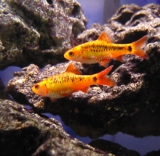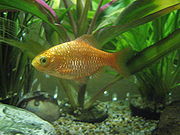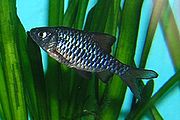
Puntius
Encyclopedia
Puntius is a genus
of ray-finned fishes in the family
Cyprinidae of the order
Cypriniformes
. Fishes of this genus are known as the spotted barbs for the predominant pattern, though many have vertical
black bands instead. Also, the Spotted Barb
proper is one particular species, Puntius binotatus. The name Puntius comes from pungti, a Bangla term for small cyprinids. The type species is the Pool Barb
(Puntius sophore), first described as Cyprinus sophore by Hamilton in 1822.
Historically, many species of Puntius have been classified in several genera, including Barbus
. Despite the reclassifications, the specific epithet remains the same in these – except in cases of homonymies –, as Barbus and Puntius have the same grammatical gender
. The closest living relatives of the spotted barbs are the Cyprinion
barbs, the Assamese Kingfish
(Semiplotus semiplotus), and perhaps the Capoeta
barbs. These and the other "typical" barbs and barbels were formerly often separated as subfamily Barbinae, but this group is highly paraphyletic with regards to the Cyprininae and better merged there at least for the largest part (including Puntius). In particular the genus Barbonymus
, containing the Tinfoil Barb
and its relatives, – for some time included in Puntius – appears to be a kind of carp
that has evolved convergently
with barbs.
 Fishes of the genus Puntius are found in Southeast Asia and India, including Sri Lanka. The maximum size for an adult of this genus is less than 25 cm (10 in), typically 15 cm (6 in), and many species only achieve around 5 cm (2 in) adult length. In appearance they may resemble miniature carp
Fishes of the genus Puntius are found in Southeast Asia and India, including Sri Lanka. The maximum size for an adult of this genus is less than 25 cm (10 in), typically 15 cm (6 in), and many species only achieve around 5 cm (2 in) adult length. In appearance they may resemble miniature carp
and are often brightly coloured or patterned. Those species
of the Puntius conchonius (Rosy Barb
) subgroup are notably high-bodied.
These fishes are omnivorous; their diet includes small invertebrate
s and plant
matter. Breeding is by egg scattering and takes place close to the bottom, near or within areas of dense plant growth. They do not show parental care, and adults may eat the young.
 These small tropical barbs are commonly kept as inhabitants of a warm water aquarium
These small tropical barbs are commonly kept as inhabitants of a warm water aquarium
, and many species are commercially available. Breed
s with elongated fins or differing colors have been produced of some of the more extensively traded species. Puntius barbs are easy to feed, taking a wide variety of foods including dried food. Note that these inquisitive fish are active and unafraid, and many species have a reputation as "fin-nippers". These are unsuitable for aquaria with slow-moving, long-finned species.
Commonly-kept Puntius species include:
in the genus
Puntius; new ones are described every few months on average:




.jpg)

Genus
In biology, a genus is a low-level taxonomic rank used in the biological classification of living and fossil organisms, which is an example of definition by genus and differentia...
of ray-finned fishes in the family
Family (biology)
In biological classification, family is* a taxonomic rank. Other well-known ranks are life, domain, kingdom, phylum, class, order, genus, and species, with family fitting between order and genus. As for the other well-known ranks, there is the option of an immediately lower rank, indicated by the...
Cyprinidae of the order
Order (biology)
In scientific classification used in biology, the order is# a taxonomic rank used in the classification of organisms. Other well-known ranks are life, domain, kingdom, phylum, class, family, genus, and species, with order fitting in between class and family...
Cypriniformes
Cypriniformes
The Cypriniformes are an order of ray-finned fish, including the carps, minnows, loaches and relatives. This order contains 5-6 families, over 320 genera, and more than 3,250 species, with new species being described every few months or so, and new genera being recognized regularly...
. Fishes of this genus are known as the spotted barbs for the predominant pattern, though many have vertical
Vertical direction
In astronomy, geography, geometry and related sciences and contexts, a direction passing by a given point is said to be vertical if it is locally aligned with the gradient of the gravity field, i.e., with the direction of the gravitational force at that point...
black bands instead. Also, the Spotted Barb
Spotted barb
The Spotted Barb or Common Barb, Puntius binotatus, is a tropical freshwater fish belonging to the Cyprininae sub-family of the family. It originates in Asia, in Myanmar and the Mekong of Thailand through Indonesia. It has also become established as an exotic species in Palau...
proper is one particular species, Puntius binotatus. The name Puntius comes from pungti, a Bangla term for small cyprinids. The type species is the Pool Barb
Pool barb
The pool barb is a tropical freshwater and brackish fish belonging to the Puntius genus in the family Cyprinidae. It is native to inland waters in Asia and is found in Pakistan, India, Nepal, Bangladesh, Myanmar, Bhutan, Afghanistan, and Yunnan, China.-Physical description:It reaches an adult...
(Puntius sophore), first described as Cyprinus sophore by Hamilton in 1822.
Historically, many species of Puntius have been classified in several genera, including Barbus
Barbus
Barbus is a ray-finned fish genus in the family Cyprinidae. The type species of Barbus is the Common Barbel, first described as Cyprinus barbus and now named Barbus barbus...
. Despite the reclassifications, the specific epithet remains the same in these – except in cases of homonymies –, as Barbus and Puntius have the same grammatical gender
Grammatical gender
Grammatical gender is defined linguistically as a system of classes of nouns which trigger specific types of inflections in associated words, such as adjectives, verbs and others. For a system of noun classes to be a gender system, every noun must belong to one of the classes and there should be...
. The closest living relatives of the spotted barbs are the Cyprinion
Cyprinion
Cyprinion is a genus of ray-finned fish in the family Cyprinidae.- Species :* Cyprinion acinaces Banister & M. A. Clarke, 1977** Cyprinion acinaces acinaces Banister & M. A. Clarke, 1977...
barbs, the Assamese Kingfish
Assamese Kingfish
Assamese Kingfish is a species of ray-finned fish in the genus Cyprinion....
(Semiplotus semiplotus), and perhaps the Capoeta
Capoeta
Capoeta is a genus of ray-finned fish in the Cyprinidae family. It was formerly included within the Barbus-Puntius complex. Today, it is restricted to a group of western Asian forms around the type species.- Species :...
barbs. These and the other "typical" barbs and barbels were formerly often separated as subfamily Barbinae, but this group is highly paraphyletic with regards to the Cyprininae and better merged there at least for the largest part (including Puntius). In particular the genus Barbonymus
Barbonymus
Barbonymus is a ray-finned fish genus in the family Cyprinidae, containing some barb species. The genus was only established in 1999, with the Tinfoil Barb as type species; thus, these fish are sometimes collectively called tinfoils...
, containing the Tinfoil Barb
Tinfoil barb
The Tinfoil Barb is a tropical Southeast Asian freshwater fish of the family Cyprinidae. This species was originally described as Barbus schwanenfeldii by Pieter Bleeker in 1853, and has also been placed in the genera Barbodes and Puntius...
and its relatives, – for some time included in Puntius – appears to be a kind of carp
Carp
Carp are various species of oily freshwater fish of the family Cyprinidae, a very large group of fish native to Europe and Asia. The cypriniformes are traditionally grouped with the Characiformes, Siluriformes and Gymnotiformes to create the superorder Ostariophysi, since these groups have certain...
that has evolved convergently
Convergent evolution
Convergent evolution describes the acquisition of the same biological trait in unrelated lineages.The wing is a classic example of convergent evolution in action. Although their last common ancestor did not have wings, both birds and bats do, and are capable of powered flight. The wings are...
with barbs.
Description

Carp
Carp are various species of oily freshwater fish of the family Cyprinidae, a very large group of fish native to Europe and Asia. The cypriniformes are traditionally grouped with the Characiformes, Siluriformes and Gymnotiformes to create the superorder Ostariophysi, since these groups have certain...
and are often brightly coloured or patterned. Those species
Species
In biology, a species is one of the basic units of biological classification and a taxonomic rank. A species is often defined as a group of organisms capable of interbreeding and producing fertile offspring. While in many cases this definition is adequate, more precise or differing measures are...
of the Puntius conchonius (Rosy Barb
Rosy barb
The rosy barb is a subtropical freshwater fish belonging to the minnow family . It originates in Bengal, India and other parts of Southeast Asia.-Physical description:...
) subgroup are notably high-bodied.
These fishes are omnivorous; their diet includes small invertebrate
Invertebrate
An invertebrate is an animal without a backbone. The group includes 97% of all animal species – all animals except those in the chordate subphylum Vertebrata .Invertebrates form a paraphyletic group...
s and plant
Plant
Plants are living organisms belonging to the kingdom Plantae. Precise definitions of the kingdom vary, but as the term is used here, plants include familiar organisms such as trees, flowers, herbs, bushes, grasses, vines, ferns, mosses, and green algae. The group is also called green plants or...
matter. Breeding is by egg scattering and takes place close to the bottom, near or within areas of dense plant growth. They do not show parental care, and adults may eat the young.
In the aquarium

Aquarium
An aquarium is a vivarium consisting of at least one transparent side in which water-dwelling plants or animals are kept. Fishkeepers use aquaria to keep fish, invertebrates, amphibians, marine mammals, turtles, and aquatic plants...
, and many species are commercially available. Breed
Breed
A breed is a group of domestic animals or plants with a homogeneous appearance, behavior, and other characteristics that distinguish it from other animals or plants of the same species. Despite the centrality of the idea of "breeds" to animal husbandry, there is no scientifically accepted...
s with elongated fins or differing colors have been produced of some of the more extensively traded species. Puntius barbs are easy to feed, taking a wide variety of foods including dried food. Note that these inquisitive fish are active and unafraid, and many species have a reputation as "fin-nippers". These are unsuitable for aquaria with slow-moving, long-finned species.
Commonly-kept Puntius species include:
Species
There are about 140 speciesSpecies
In biology, a species is one of the basic units of biological classification and a taxonomic rank. A species is often defined as a group of organisms capable of interbreeding and producing fertile offspring. While in many cases this definition is adequate, more precise or differing measures are...
in the genus
Genus
In biology, a genus is a low-level taxonomic rank used in the biological classification of living and fossil organisms, which is an example of definition by genus and differentia...
Puntius; new ones are described every few months on average:




.jpg)

External links
- Odessa Barb species profile - AquariumDomain, see: http://www.aquariumdomain.com/viewSpeciesFreshwater.php?id=6
- Article on P synderi and comparison with P semifasciolatus, see: http://zoolstud.sinica.edu.tw/Journals/45.2/149.pdf
- Genetic studies of some South Asian Puntius species, see:
- http://www.journalarchive.jst.go.jp/jnlpdf.php?cdjournal=pjab1977&cdvol=53&noissue=6&startpage=231&lang=en&from=jnltoc
- http://www.journalarchive.jst.go.jp/jnlpdf.php?cdjournal=pjab1977&cdvol=53&noissue=7&startpage=282&lang=en&from=jnltoc
- http://www.wdc-jp.biz/pdf_store/isj/publication/pdf/25/251/25101.pdf
- Puntius stoliczkanus http://nels.nii.ac.jp/els/contents_disp.php?id=ART0006479298&type=pdf&lang=en&host=cinii&order_no=Z00000014593846&ppv_type=0&lang_sw=&no=1203405309&cp=
- Puntius phylogenetic tree http://www.bmnh.org/PDFs/FB_04_Science.pdf
- Odessa barb - P padamya identification paper (2008), see link:
- http://ichthyology.tau.ac.il/2008/KullanderBritz.pdf

